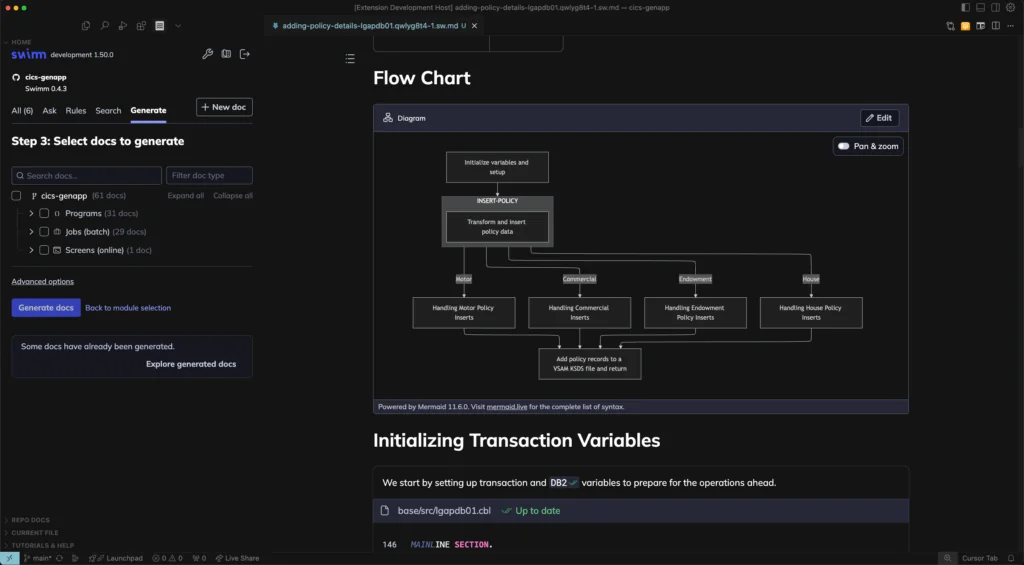How Is AI Transforming Mainframes?
A mainframe is a high-performance computer capable of processing massive amounts of data quickly. It is specifically designed for large-scale commercial and government applications, managing thousands of users simultaneously. As AI technology gains a prominent role in the economy, organizations are keen to use AI technology within the mainframe ecosystem.
Adding AI to mainframes brings advanced analytics and decision-making closer to the data, especially in environments where data privacy, speed, and reliability are essential. Instead of transferring sensitive data to the cloud, companies can run AI models directly where their data resides—on the mainframe—enabling faster insights.
This shift is driven by three primary use cases:
- Embedding AI directly into transactional workloads: Delivers real-time insights that improve business responsiveness and decision speed. For example, mainframes running financial applications can use AI to detect fraud or make credit decisions instantly.
- Using AI to optimize the mainframe itself: Intelligent infrastructure powered by AI can predict system loads, allocate resources proactively, and detect anomalies before they impact performance or uptime.
- Leveraging Generative AI: Used on mainframes to automate the creation of business content, code, and workflows. By integrating generative models directly into mainframe environments, organizations can automate documentation, generate system reports, and assist in writing or modernizing COBOL and other legacy codebases.
Modern mainframes, such as IBM z16, are equipped with on-chip AI accelerators that allow high-throughput, low-latency processing of AI workloads. These chips can handle millions of inference requests per second, enabling scalable AI applications without the need to offload data to external platforms. This supports a co-location strategy, where data, business logic, and AI models operate within the same environment.
This is part of a series of articles about mainframe modernization
Embedding AI into Transactional Workloads
Embedding AI into transactional workloads enables real-time intelligence directly within operational processes. Mainframes can integrate AI models into critical transaction flows, such as payment processing or order management, to make immediate predictions and decisions. For example, AI can detect fraudulent transactions in milliseconds during credit card authorization, preventing fraud without delaying customer experience.
Another common use is real-time personalization. In industries like banking and retail, AI models can analyze transaction patterns and customer behavior as transactions occur. This allows systems to dynamically adjust offers, recommend products, or personalize service experiences without waiting for batch processing or offline analytics.
Using AI to Optimize Mainframe Operations
AI is transforming mainframe operations by bringing predictive and autonomous management capabilities. By continuously monitoring system performance metrics, AI models can predict workload surges, proactively allocate processing power, and adjust storage and memory resources to avoid performance bottlenecks. For example, AI can automatically scale up capacity before month-end financial closings when transaction volumes spike.
AI also assists in anomaly detection and incident prevention. Machine learning models trained on system logs and telemetry data can identify patterns that precede hardware failures, security breaches, or software crashes. When anomalies are detected, AI systems can alert operators or even trigger automated remediation workflows, minimizing downtime.
Leveraging Generative AI for the Mainframe
As mainframes continue to support critical business operations, generative AI is emerging as a practical tool to modernize development, improve efficiency, and address workforce challenges. Generative AI improves productivity, accelerates modernization and mainframe migration projects, and enables automation within the reliable mainframe environment.
Here are several practical use cases for generative AI on the mainframe:
- Mentorship and learning support: Generative AI acts as an on-demand expert, guiding new developers through platform-specific topics like VSAM or COBOL performance optimization. It helps reduce the learning curve and improves productivity without exposing sensitive data.
- COBOL code translation: Tools that use generative AI to convert legacy COBOL code into modern languages such as Java. This supports system modernization efforts while preserving transactional logic and performance.
- Automation for business agility: Developers can use generative AI to generate scripts, such as those using Zowe CLI, to automate mainframe tasks. This reduces manual work, speeds up development, and improves time-to-delivery for mainframe applications.
- Synthetic data generation: Generative AI creates synthetic test data that mimics production datasets without containing sensitive information. This is especially valuable for testing in industries with strict data privacy requirements.
- Mainframe code generation: Generative AI assists in generating COBOL or assembler code by understanding mainframe-specific syntax and structure. It provides working code snippets, reducing the effort needed to start from scratch.
- REXX script creation: As much mainframe automation still relies on REXX, generative AI supports scripting by helping developers understand and write REXX code more efficiently.
- Code explanation and documentation: Developers can use generative AI to explain complex COBOL code blocks, making legacy systems easier to understand and maintain. This helps ensure continuity and knowledge transfer.
- VSCode integration for AI-assisted development: With generative AI extensions in VSCode, developers get inline suggestions, code generation, debugging help, and documentation within the IDE. This improves coding speed and reduces context switching.
Notable Mainframe AI Tools
1. Swimm
Swimm’s Application Understanding Platform helps solve one of the biggest challenges in modernization – the lack of understanding of existing applications. Swimm is able to be deployed in highly secure environments and uses deterministic static analysis and generative AI to produce proven, reliable and cost-effective insights.
Key features include:
- Business rule extraction: Accurately extracts all the business rules and logic in the codebase.
- Architectural overviews: Finds and explains the component architecture of the application and breaks down programs, jobs, flows and dependencies.
- Natural language: Turns vague program and variable names into descriptive names for quickly understanding connections and flows.
- Customizable support: Supports complex and proprietary implementations of COBOL, CICS, and PL/I through language parsers and company specific plug-ins.

2. IBM Watsonx Code Assistant for Z

IBM Watsonx Code Assistant for Z is a generative AI-powered tool to modernize mainframe applications. It supports the application lifecycle using automation and large language models to assist developers in understanding, optimizing, and converting legacy COBOL code.
Key features:
- Application understanding: Visualizes code structure, relationships, and dependencies to improve comprehension of large-scale COBOL applications.
- Code explanation: Automatically generates natural language documentation for COBOL and JCL code.
- Automated refactoring: Breaks down monolithic COBOL programs into modular services for manageability.
- Performance optimization: Recommends improvements to COBOL code for better efficiency and performance.
- Language transformation: Converts COBOL code into object-oriented Java using AI, maintaining semantic accuracy through automated testing.
Source: IBM
3. BMC Automated Mainframe Intelligence

BMC Automated Mainframe Intelligence (BMC AMI) is a platform that integrates DevOps, AIOps, DataOps, and generative AI to simplify management, improve performance, and reduce operational risks. BMC AMI enables enterprises to transition from reactive to proactive mainframe management by automating workflows and accelerating decision-making.
Key features:
- DevOps acceleration: Simplifies development pipelines by automating repetitive tasks.
- Integrated automation: Improves workflow efficiency across the application lifecycle, reducing deployment times and improving delivery frequency.
- Team collaboration: Simplifies mainframe operations, promoting consistent practices and improving coordination across teams.
- DataOps for hybrid cloud: Integrates mainframe data into cloud environments, reducing legacy overhead and enabling scalable data access.
- Real-time insights: Provides instant access to operational data to support faster business decisions.
Source: BMC
4. Avanade’s Automated Migration Technology

Avanade’s Automated Migration Technology (AMT) is a modernization platform to help enterprises transition from legacy mainframe systems to scalable, flexible architectures. It combines automation, proven methodology, and generative AI to accelerate and de-risk mainframe migration projects.
Key features:
- Modernization paths: Customizes migration strategies based on each organization’s business and technical requirements.
- Generative AI integration: Uses AI to generate system documentation and test data, improving accuracy and speeding up transformation.
- Automated migration: Leverages proprietary tools to automate code, data, and process migration.
- Tech debt remediation: Supports analysis and structured modernization to eliminate technical debt.
- Low-risk execution: Minimizes operational risk through tools, repeatable methods, and rigorous validation.
5. Google Cloud Mainframe Modernization Solutions
Google Cloud Mainframe Modernization Solutions combine cloud infrastructure, generative AI, and a broad toolset to accelerate the transformation of legacy mainframe environments. With Gemini-powered models and automated modernization workflows, organizations can assess, refactor, rewrite, replatform, and augment their mainframe applications.
Key features:
- AI-powered assessment (MAT): Analyzes applications and dependencies using the Mainframe Assessment Tool, supported by Gemini models for automated documentation, test case generation, and modernization insights.
- Generative AI code rewrite: Transforms legacy mainframe code into modern languages like Java using Gemini Code Assist within familiar IDE environments.
- Automated refactoring: Converts mainframe batch workloads to Java and deploys them on Google Kubernetes Engine (GKE) or Cloud Run.
- Replatforming to cloud: Moves mainframe applications “as-is” to Google Cloud with partner-driven tools.
- Dual run for de-risking: Certifies the accuracy of modernized applications by running them in parallel with production systems, comparing results to validate business logic.
Source: Google Cloud
Related content: Read our guide to mainframe modernization companies
Conclusion
Generative AI is reshaping how organizations manage, modernize, and develop on the mainframe. By embedding intelligence directly into the platform, enterprises gain faster decision-making, improved automation, and enhanced developer productivity. This integration helps reduce technical debt, optimize performance, and extend the value of existing systems.
Related content: Read our guide to aws mainframe migration